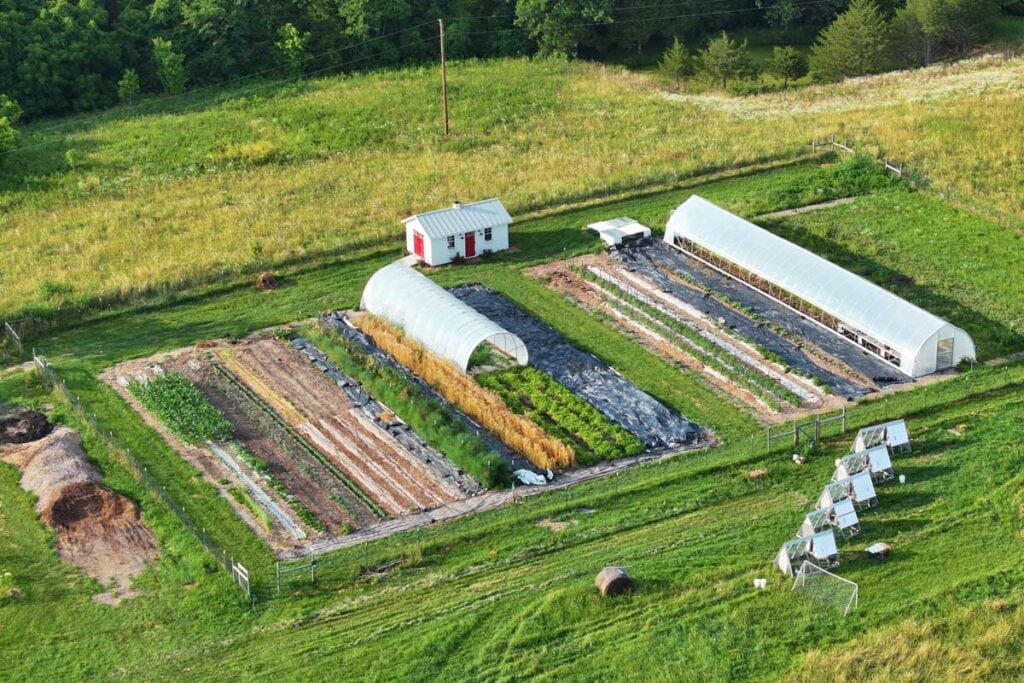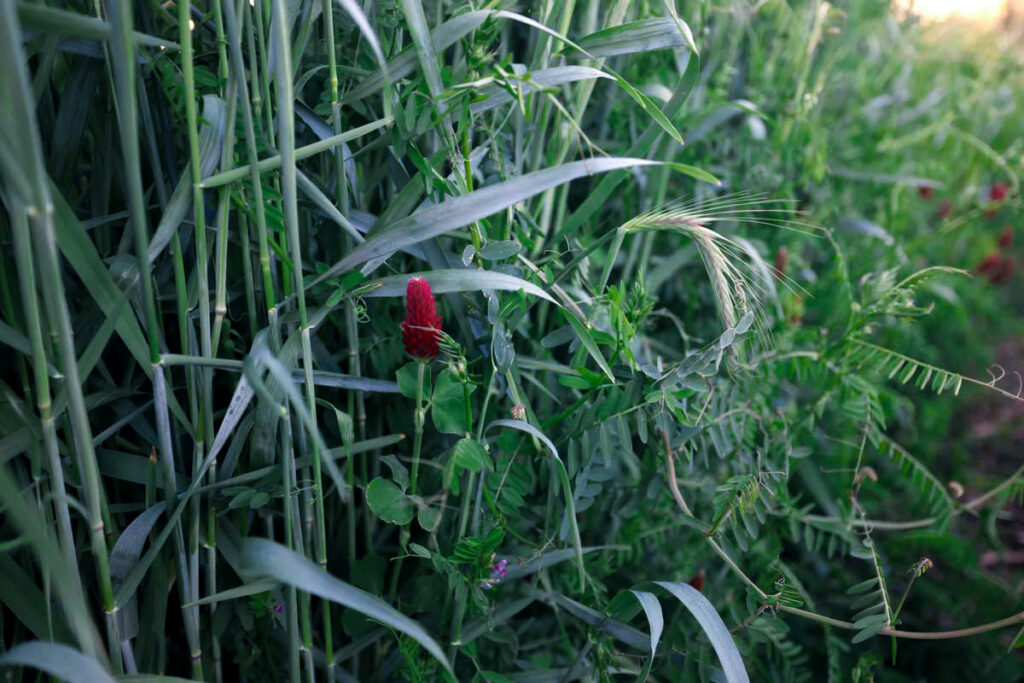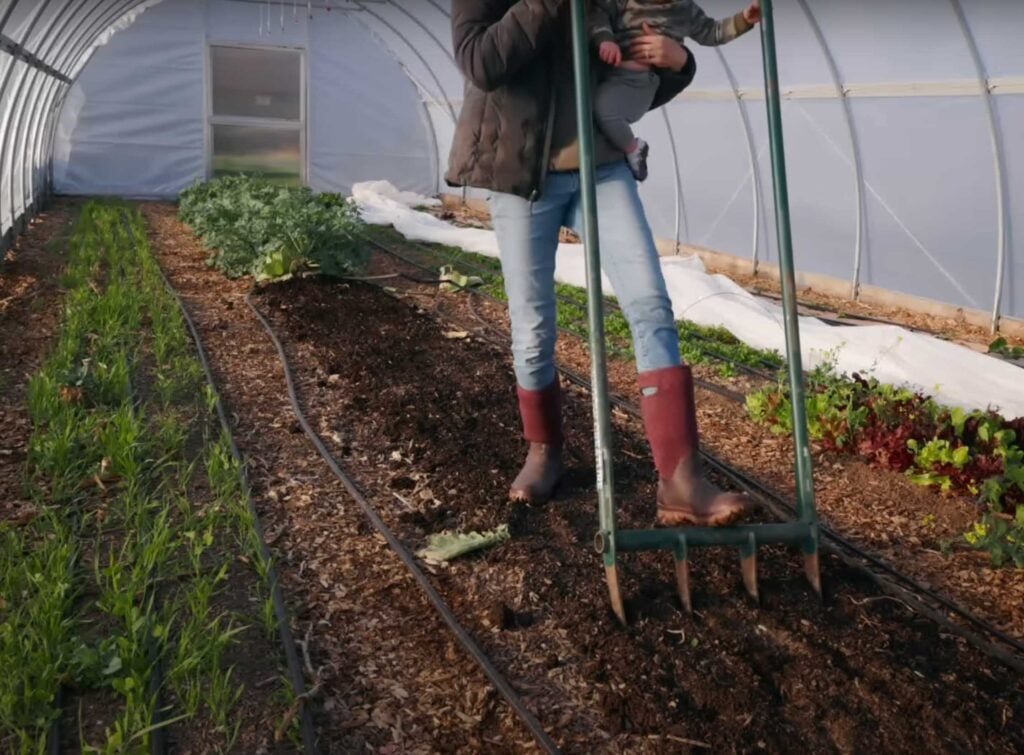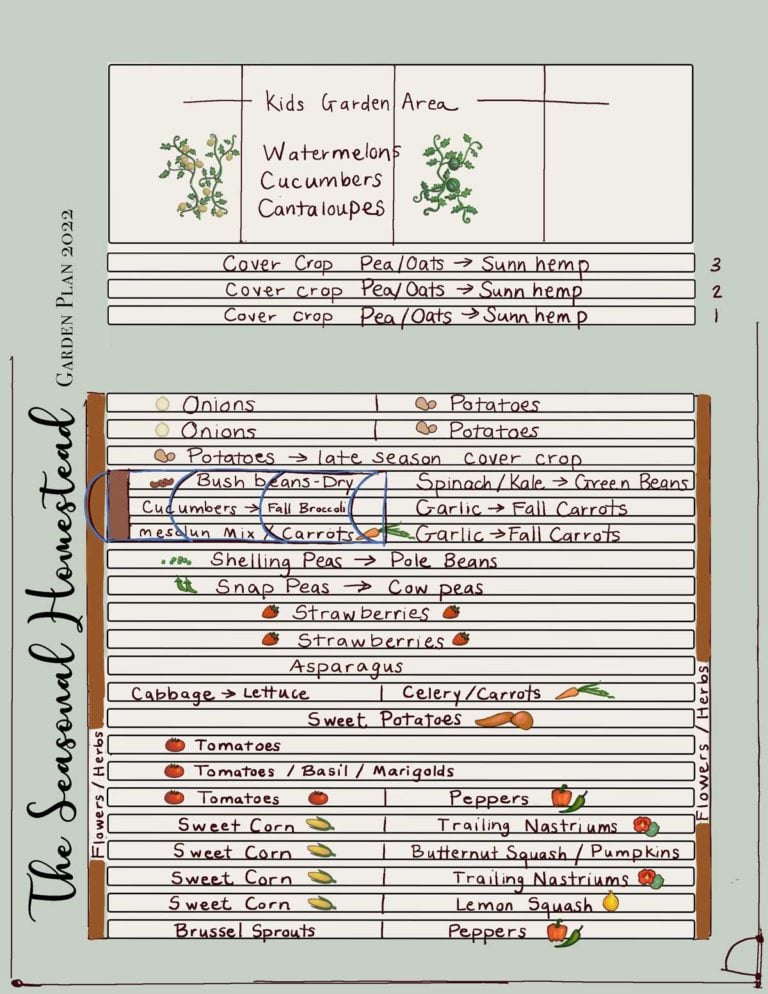The Problem with No-Till Gardening
No-till gardening is a huge gardening trend. It has been rapidly gaining popularity among growers for the last few decades.
Even though no-till gardening has been around for much longer than that, its benefits and drawbacks are now more widely known and researched. I’ve run into a few problems with no-till and wanted to bring to light the fact that no-till is not all smooth sailing or as rosy as it’s portrayed.
This post contains affiliate links. Here is the full disclosure.

What is No-Till Gardening?
The definition of no-till varies based on source, but there are some basic principles that most agree on. First, no-till gardening is disturbing the soil as little as possible.
Second, no-till gardening and minimal soil disturbance is an effort to increase soil life and biology, and increase soil health.
Third, occasionally no-till advocates are ok with a one time tillage to transition from sod to plantable vegetable beds.
A Deeper Explanation No-Till Farming and Gardening
Here are a few definitions of well known farmers, gardeners, and authors.
In the book, The No-Till Organic Vegetable Farm by Daniel Mays, he says “proper care of the soil can be summarized with four principles… maximized photosynthesis, extensive diversity, complete soil coverage, and minimal soil disturbance.”

Jesse Frost, in The Living Soil Handbook says, “It comes down to three basic principles: Disturb the soil as little as possible, keep the soil covered as much as possible, and keep the soil planted as much as possible.”
He further goes on to say, “ When the practice of no-till is a grower’s primary tool for stewarding the soil, “as possible” must be their mantra… They encourage the grower to be reasonable… pulling carrots disturbs the soil. Raking disturbs soil. Animals disturb soil. It’s okay. Just disturb the soil as little as you possibly can in your context.”
No-Till Gardening vs. No Dig Gardening
No-till gardening is often confused with no dig gardening. There are many similarities but from my research I’ve found a few key differences.
As far as I know, the term “No Dig” was coined by Charles Dowding. In no dig gardening, even broadforking is considered too much soil disruption. Based on a trial, Charles found 5% less yield in the soil that was broadforked.

Another difference is that no dig focuses heavily on improving the soil with compost. He also uses green manures occasionally and animal manure. No fertilizers are used, even organic fertilizers like blood meal are not added.
Interestingly, on the no dig FAQ page, Charles says that doing no dig on a farm scale is called no-till and it uses less compost. He also says in no-till farming more tarps are used.
My Experience with No-Till as a Large Scale Home Gardener
There are so many case studies (cited at the end of this article) proving the benefits of no-till gardening. Therefore, it is hard to refute the fact that no-till gardening definitely is beneficial for the soil and soil health.
That being said, I want to share my experience of a few of the difficulties and drawbacks of implementing no-till, especially for a larger scale home garden.

My garden is roughly 15,000 square feet in size or about a third of an acre. Not all of that is in production at one time, part of my fertility program is to grow cover crops on at least a quarter of the garden at any one given time.
The reason we have such a large garden is we grow all our vegetables throughout the year, no supplementation from outside sources.
The First Few Years
I have been gardening for nearly 20 years now, and during that time I used mostly raised beds that were filled with soil and organic matter. I never tilled the soil at any point until I started a garden in the ground.
It’s pretty easy to do no dig or no-till when you’ve got only a few raised beds. But when the scale increases and the soil is like a brick filled with rocks, things get interesting.
In 2020, we bought our current property of 52 acres. We have plenty of space to grow food but we limited the garden to an ⅛ of an acre the first year, and expanded to a ¼ acre by the second year.

We tarped the soil with a silage tarp for a month, then opted to do the one time tillage with a rotary plow and BCS tractor to make permanent mounded rows.
The time was 2020, when resources were scarce due to the pandemic. We incorporated sand and a small amount of peat moss into the soil due to the fact that compost was sold out everywhere and unavailable. Halfway through the season we rounded up some wood chip mulch to use in the pathways.
By the second year, compost was available and we started to add it to the garden. But we soon realized we had a problem.
To add an inch of compost over the whole garden, 30 cubic yards are needed to cover the entire quarter acre space. Our usual pick up bed filled with a cubic yard wasn’t going to cut it anymore.
The Compost Challenge
So there are a few challenges that immediately popped up. One, how would we get compost to our garden? And two, how much would this cost?
Making my own compost wasn’t even an option since in my experience generally it takes 4 times the amount of material to break down to the finished product. So if I were to make 30 yards of compost, I would need 120 yards of organic materials to begin with. This is not practical for a home grower, or at least not this home grower 🙂
Breaking down the numbers of Cost of Compost Per Year
In order to get compost on our property, we needed to discuss the options. Option one, use our truck bed to get compost. Our pick up truck bed can fit a maximum of 2 yards of compost. Therefore we would need to make 15 trips to the compost facility to get 30 yards with this option.
Option two was to rent a dump trailer. A dump trailer that works with our size truck (Ford F-150) can haul 5 cubic yards at a time. This is the option we went with.
The dump trailer cost $230 a day to rent. The only bulk organic compost we could find was 1.5 hours away so we were able to get two loads or 10 yards per day.

So $230 for the rental + 10 yards of organic compost @ $40 a yard + $60 gas cost = $690. Multiply that by three trips and the total cost per year in compost is $2070.
Each year we need at least this amount of compost, if not more, to maintain our no-till garden. When we set up our high tunnel, we tarped and did not plow at all. Instead we opted to place a 4 inch layer of compost over that soil.
It’s beautiful workable soil now, don’t get me wrong, but it was expensive to get started! At 4 inches compost over that 1000 square foot area, the amount of compost needed was 13 yards, or a little more than $1000 end cost.
This doesn’t include the fact that we take off a day of work to make the trips and therefore lose even more money.
What about Dump Truck or Semi-truck delivery for compost?
We have thought about using the bulk delivery service the compost business provides. However, we soon realized it was not possible.
Our property has a 11% grade gravel driveway that is narrow and has a tight corner turn at the top. It is completely inaccessible by semi-trucks. A dump truck is a possibility but it hauls much less and we would need to hire our own driver instead of using the compost company’s delivery service.

We worked out the numbers and this was more expensive. We even considered changing our driveway to have a wider turn at the top and paving it (bid came in at $50,000). The other option was making a drive accessible for a semi-truck on our lower property.
Is Adding all the Compost for a No-Till Garden Actually Sustainable?
Over the last few years of continuing on with this process, I’ve questioned many times if this is really a sustainable practice? We are spending so much time, money, not to mention wear and tear on our vehicle to get the compost we need each year.
Then when the compost is here, it needs to be hauled to garden beds. This uses more time, more man power, and it is hard on the body.

Even though I’m not one to shy away from work, I cannot see myself keeping this practice up especially the older I get.
So much of no-till and no dig gardening is based around having a boat load of organic materials, specifically compost to add to the garden.
Cover Crops, Livestock, and Mulch to the Rescue
Even though most no-till gardening relies on huge organic matter inputs, over the last few years, I’ve found a few examples of exceptions that piqued my curiosity. These were large scale growers like Gabe Brown and market gardeners like Iain Tolhurst.
Instead of using endless amounts of compost, multispecies cover crops are used. These cover crops add the needed organic matter and fertility.

The two growers differ in that Gabe Brown at Brown’s Ranch also uses livestock. He uses them to enrich soil on a large scale.
Iain Tolhurst at Tolhurst Organic runs a stock-free organic vegetable farm. He uses no added fertilizers and no added animal inputs or manures. He uses only cover crops for fertility. Additionally, he recently added wood chips to the fertility program and makes compost with them.
The caveat with both methods is that often some type of machinery is needed, like a tractor. Obviously when farming on a larger scale a tractor makes sense.
I kept thinking, what if I could take this down to my scale. How can I implement some of these practices instead of purchasing 30 yards of compost per year?
A Tractor for a Small Farmer or Large Scale Home Gardener
Early on in our no-till journey, we discovered we didn’t have the time to tarp for an entire season and wait for perennial weeds to die. As a result, we purchased a BCS Tractor and a rotary plow.
This was a game changer for us since we were able to do our one-time plow and mix in some organic matter. The BCS is perfect for a large scale gardener who doesn’t want the compaction of a heavy full size tractor inside the garden.
I will go into how the small tractor has helped us in more detail but first I need to share my worst experience with no-till.
When Purist No-Till Growers Take it to the Next Level
I can’t help but mention at this point the amount of trepidation I feel when I share anything about no-till gardening. This feeling comes because we document all our gardening on our Youtube channel. I learned early on that any mention of no-till in the video brought a slew of passionate growers who took the idea of “disturbing the soil as little as possible” to the next level.

One time, I used a broadfork for our carrot bed and immediately received several comments of “why do you claim to be no-till if you use a broadfork?” I was taken aback by this because I was still trying to do the no-till method. Yet because I wasn’t an absolute purist I was berated.
This is where Jesse Frost’s words of context came into my mind. In my context, the soil is so heavy a carrot literally can not push through and make a straight root. Consequently, a broad fork was necessary to get a decent crop of carrots.
A Major Drawback of No-Till Gardening
A problem we ran into with no-till gardening happened three years after initially setting up the garden. As time had passed, the garden beds all leveled out with the walking paths, even with the addition of compost.
That summer, I planted 100 tomato plants, directly into a cover crop. The cover crops had been crimped and tarped a few weeks prior. Over the next week and a half watched as half of the tomatoes died from poor drainage due to non stop rain.
I had done what no-till gardening wisdom claimed to be the right thing by not touching the soil and yet my plants died. How could this be?
After sharing this on video, some growers said I didn’t give it enough time, while others insisted my one time tillage three years prior was still affecting my soil and causing it to drain poorly. Yet others said it was my occasional broadforking that caused this poor drainage.
I considered all the feedback, and concluded that yes, my soil needed some more time. However, in response to the idea that a one time tillage caused all the drainage problems, I will state a few facts that hopefully help some else out there with similar soil that is frustrated.
Our land where the garden is has silty-clay soil and a lot of rocks. Previously, it has been a pasture with cattle on it for 30 years. Every part of the pasture soaks up the water like a sponge and then does not drain.

If you dig a hole in the soil, it instantly becomes a pond, no liner necessary. Additionally, our septic field is enormous because of how poor the drainage is on the land- everywhere- not just in the garden. I say all that because my one time plowing absolutely did not cause poor drainage. It was already here.
There are hundreds of studies proving that no-till improves drainage. Yes. I believe it. But it’s not going to happen overnight or even in a few years.
Moving Forward with a Different Idea
In my context, my absolute adherence to no-till caused a devastating tomato crop failure.
So the next year, I said forget it, I am digging out walkways so my garden bed soil is raised and I don’t lose my tomatoes again.
I didn’t touch the actual garden beds, but I most definitely plowed the soil from the walking path onto the garden bed with my BCS plow.
Again, I think of the words, disturb the soil as little as possible in your context. My context is far different than someone with sandy, well draining soil. I need to treat it differently. Especially until we get further along with building soil fertility and the ability of water to drain deeply.
If I had loaded four inches of compost to the surface of the garden bed, would the tomato disaster have happened? No, probably not. I’m sure that was part of my failing. But like I said earlier, adding massive amounts of compost from outside sources is not sustainable.
I finally came to terms with the fact that it’s ok to raise my garden beds with native soil so that I don’t have a crop failure. We are working towards less disturbance but not perfect at it.
No matter where you fall in terms of the spectrum of beliefs with no-till, my hope is that sharing my story will add some much needed reality into this equation.
Deviating Even Further from the No-Till Gardening Purist Mentality
We are now moving forward with a different plan to grow more cover crops. We also plan on keeping all the cover crop residue in the garden. This will allow us to eliminate a large amount of the hauling of compost and cost.
Last year, we purchased a flail mower attachment for the BCS tractor. It shreds cover crops and even vegetable crops down to tiny pieces so they can break down quickly.
Another problem I had with being a no-till purist was garden bed preparation. Since our soil is hard, especially in the dry summer, when it came time to plant a new crop I manually took a garden hoe and cultivated the entire area.

This cultivation loosed up the top 2 inches of the soil. It also allowed me to use the seeder because otherwise it would never penetrate the soil and seeds would be laid on top.
I was doing all this by hand because I didn’t want to disrupt the soil with a machine. And yet, my hoe was still going 2 inches under the soil and disrupting all kinds of things!
I Traded Prepping the Soil with a Hoe to Prepping with a Power Harrow
I was fed up with the time that this took, and looked into other garden tool options. The first being a tilther. This is a $650 machine that blends the top 2 inches of soil into a finely ground tilth ready for planting. Exactly what I’ve been doing by hand but faster and easier!
The second option was an attachment to the BCS tractor called a power harrow. A power harrow stirs the soil with an egg beater motion to create a uniform seed bed. It is very powerful but can be set to only an inch or two deep.
Consequently, use of the power harrow results in the same uniform seed bed. It disrupts the soil a little but only at an inch or two deep.
Further, it’s important to realize, this isn’t deep tillage. It doesn’t destroy soil structure like a tiller. Why make life harder by doing the same action but by hand? It didn’t make sense to me.
Is the Cost of Using a Tractor and Attachments Worth it?
The cost of the power harrow is $2700 for the attachment. Though it is more expensive than a tilther, we opted to purchase the power harrow. This is because it doesn’t require a drill and battery which would drain quickly.
I also have a farm friend who told me his tilther was “a piece of junk” and he was fixing it all the time. (This was the old style- Johnny’s Seeds has recently updated the tilther).
So the power harrow came last week. Immediately, we tested it out, setting the machine to go an inch and a half deep into the soil. After one use, I practically cried with how much time we had just saved.
The result was exactly what I was manually doing with a hoe to prepare a garden bed for direct seeding. Yet it was done in a fraction of the time. My earthway seeder moved through the soil with ease. I pressed my finger into the soil and found it was loosened only to my knuckle on my pointer finger.
The power harrow, flail mower, and use of cover crops will allow us to move away from compost almost entirely. Or at least that is the hope. At $2700, the power harrow was expensive. But if we aren’t buying compost, the investment will pay off in just over a year. Definitely worth it in my opinion.
Conclusion
So we may now no longer be considered no-till gardeners but honestly, that is a relief. I’m tired of living up to the unrealistic expectations of a trend and the people that bring us down because we aren’t no-till purists.

Sometimes it is necessary to break away from no-till dogma and be realistic about what the soil needs. An observant gardener can learn by visual clues, plant health, and yields what is working and what is not.
For a long time, a super successful market gardener friend of mine had the description of his certified organic market garden as no-till. He has since changed his terminology to “minimal till”.
I love the transparency and might have to adopt the term myself! It steps away from the absolutes of no soil disruption ever, and allows for taking steps toward less soil disturbance with some wiggle room.
I’ll end with a good quote from the book The Living Soil by Jesse Frost.
A quote by Jesse Frost on No-Till Growing
Though avoiding soil disturbance as much as possible is important, the enterprise of creating and protecting living soil isn’t beholden to the goal of no disturbance ever. Indeed, I believe each farmer will discover that their path to stewarding living soil evolves as much through dedication to no dogma as it does to no disturbance.
As long as you use a given tool to promote soil life and biology, you are advancing toward the goal. This means keeping an open mind about soil practices that can create temporary soil damage, because those practices may ultimately create a more friable soil.
Sometimes promoting soil life involves using a disc or a tiller to work in composts and amendments, especially when starting a new garden. Other times it includes broadforking to break up compaction, which allows for better water infiltration and soil respiration that in turn promotes photosynthesis… At first you may have to undertake more disturbance than you see other growers doing. Don’t worry about all that- focus on what your soil needs in your context and it will thrive.
Case Study Examples for No-Till Gardening or Zero TIllage Farming Practices
- https://cslc.colorado.edu/2020-trends/conventional-tillage-practices-linked-to-poor-soil-health
- https://understandingag.com/regenerative-successes/case-studies/
- https://extension.umaine.edu/agriculture/soil-health/no-till-and-reduced-tillage/no-till-management-case-study-stoneyvale-farm/
- https://attra.ncat.org/publication/no-till-case-study-miller/
- https://www.sare.org/publications/conservation-tillage-systems-in-the-southeast/chapter-18-southern-coastal-plain-and-atlantic-coast-flatwoods-case-studies/case-study-farms/



